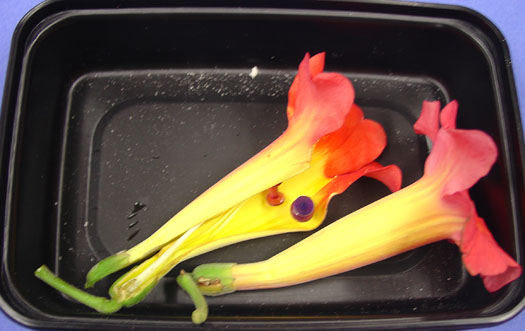|
OBJECTIVES:
VOCABULARY:
MATERIALS: ELECTRONIC
BACKGROUND:
Insects, and some
other animals, regularly visit flowers for the sugary nectar and
protein-rich pollen they produce. This act of pollination is the first
step in fruit and seed production. Any insects, birds, and bats act as
pollinators. Both the plants and their animal pollinators have developed
unique relationships and structures that allow them to successfully
interact. For example, the long tongue (proboscis) of moths and
butterflies allows them to reach nectar produced deep inside of flowers.
In many cases both the animal and the plant benefits from this interaction
as the animal obtains food and the plant is pollinated. However, some
animals may steal nectar or pollen without
Humans also are
dependent on insect-pollinated plants for foods, medicines and clothing.
Worldwide three-fourths of all food and feed crops require pollinators to
reproduce. We can even thank a species of fly for pollinating the cocoa
plant that we use to make chocolate!
Successful
pollination depends on pollinators finding the right flowers at the right
time.
Pollinators locate
appropriate flowers by visual and chemical cues. Since the structure of
the mouthparts of pollinators differ greatly as do flower structures, the
pollinator also has to locate the right type of flower.
Key Points
·
Adaptations such as bright colors, strong fragrances,
special shapes, and nectar guides are used to attract suitable
pollinators. PROCEDURE:
Flowers contain
many structures. Not all
flowers have all the idealized parts and some are hard to see.
In this activity students will discover the parts of a flower that
is available. We will describe
the stamen, style, sepals and petals.
§
Slide
1.
First review that flowers make seeds using pollen.
PollInators get food as they travel from plant to plant.
§
Ask
them to name a few pollinators they know.
§
Flowers
are bright to bring the pollinators to the flower.
§
Slide 2. Go
over the parts of a flower.
Tell them the main four to remember are pistil, stamen, petal and sepal.
Ask them at the end what those four do. § Slide 3. Pass out handout. Tell them they are going to make a color guide for flowers. Ask them to color the word petal and then color the petals in the drawing the same color. It doesn’t matter what color they choose as long as the name and flower part are the same. Repeat for other words.
2.
Collect flowers that children will dissect.
Use meat trays for the students to perform their dissection.
 3. You may want to use a plastic knife or scissor, depending on what plant you have found to dissect. Ideally it would be good for each child to have their own flower. You also may want to get 2-4 different types of flowers and have the students compare amongst.
4.
Carefully cut the long way and set them side by side.
5.
Compare
with the diagram from their worksheet and have them try and identify each of the
components from the flower.
Petals
are modified
leaves
that surround the reproductive parts of
flowers. They are often
brightly colored or unusually shaped to attract
pollinators.
Together, all of the petals of a flower are called a corolla.
Petals are usually accompanied by another set of special leaves called
sepals, that collectively form
the calyx and lie just beneath the corolla. Sepals
protect the flower before it opens and can support the petals when the
flower is in bloom
Stamens produce the pollen and pistils house the future seeds. A pistil
typically consists of an expanded basal portion called the ovary,
an elongated section called a style and an apical structure that
receives pollen called a stigma.
6.
You can have the
students try to draw their flower and its parts on the sheet.
Flowers are different so the 4 structures can be quite different
depending on the species. Some
flowers do not have all parts.
|